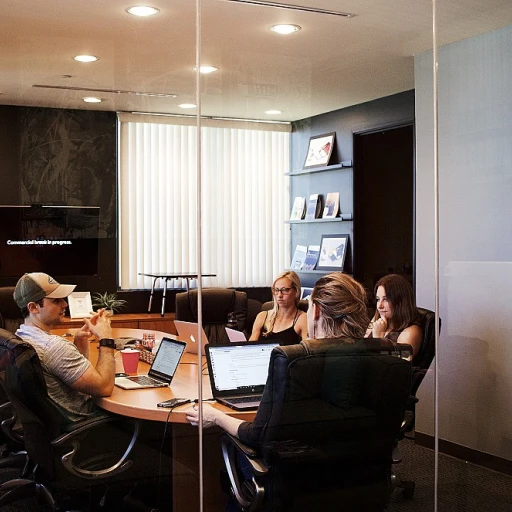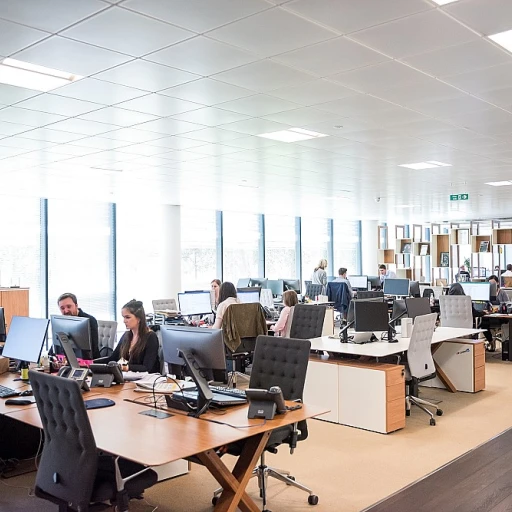
Understanding Environmental Branding
Defining Environmental Branding in Corporate Spaces
Environmental branding is a strategic approach that integrates a company's brand identity into its physical spaces, creating a cohesive brand experience. This involves the use of environmental graphics, signage wayfinding, and interior design to reflect the brand's mission values and visual identity. The goal is to create immersive, branded environments that enhance the overall brand experience for employees, clients, and visitors.
Incorporating branding design into corporate spaces involves more than just placing a logo on a wall. It requires a thoughtful design team to create installations that resonate with the company's culture and values. This can include digital signage, pole banners, and wayfinding signage that guide and inform while reinforcing the brand's presence.
The Impact of Environmental Design on Brand Identity
Successful environmental branding projects can significantly enhance a company's brand identity. By integrating branding environmental elements into the office environment, companies can create a space that not only looks aesthetically pleasing but also communicates the brand's ethos. This can lead to a more engaging and memorable brand experience for everyone who interacts with the space.
For instance, universities and large corporations often use environmental design to create spaces that reflect their brand values and mission. This approach not only strengthens the brand's identity but also fosters a sense of belonging and pride among employees and stakeholders.
To explore more about how office managers can implement transformative strategies in their workspaces, you can read about transformative strategies for office managers.
The Role of Cultural Nuances
Incorporating Cultural Element to Reflect Brand
When undertaking an environmental branding project in India, it’s crucial to recognize and respect the rich tapestry of cultural nuances that distinguish this vast country. Indian companies understand that adapting their environment and physical spaces to resonate with local culture can significantly enhance brand identity and reflect brand ethos effectively. Cultural considerations in design involve more than just color palettes or motifs; they encompass a blend of diverse languages, symbolic graphics, and historical heritage that contribute to creating a cohesive brand experience. For many companies, incorporating these elements in their branding design means embracing traditional patterns and integrating subtle cues that align with their brand mission values. From choosing the right interior design to crafting impactful signage wayfinding and pole banners, these elements become seamlessly integrated into the branding environmental strategy. Incorporating digital dimensions like digital signage is equally pivotal. Many Indian offices have begun merging traditional visual identity with modern digital installations, utilizing technology to enhance user experience while maintaining cultural integrity. This fuses the global with the local, crafting branded environments that emphasize intercultural significance. The design fabrication process often includes collaborations with local artisans to create personalized environmental graphics that depict symbolic and regional stories. This practice not only enhances the brand’s narrative but also supports local craftsmanship, ensuring the brand space is both immersive and evocative. Ultimately, Indian companies are presented with many successful opportunities to implement cultural elements in their environmental design. This intricate process, when executed thoughtfully, ensures the environment truly becomes a reflection of the company’s identity. For more insights into transformative strategies for office managers in Indian companies, consider exploring this resource: Greening the workspace.Sustainable Practices in Office Design
Integrating Sustainability in Interior Design
In today's day and age, office spaces are not just about accommodating employees; they're about creating an environment that reflects a company's brand identity and sustainable values. The incorporation of sustainable practices in office design plays a crucial role in achieving this. It's not only about minimizing the carbon footprint but also about creating an immersive brand experience that resonates with employees and visitors alike. When designing environmental branding for physical spaces, it is important for companies to integrate eco-friendly materials and energy-efficient solutions into their projects. Using recycled materials in design fabrication and branded installations can significantly enhance sustainability efforts. The choice of materials for interior designs, such as energy-efficient lighting, reusable graphics, and digital signage, can shape an office's visual identity while promoting a brand's mission and values. Moreover, integrating green initiatives into branding design helps a company visibly demonstrate its commitment to sustainability, often creating unique environments that leave lasting impressions. Elements like branded graphics and interior signage wayfinding not only assist in navigation but also reinforce the corporate ethos. For companies looking to create immersive spaces, collaborating with a creative design team is essential. They can help develop a seamless integration of the brand into the environment, ensuring that every element reflects and enhances the brand. From the lobby signage to the pole banners, each component should convey the brand ethos while adhering to sustainable practices. The transformative power of environmental branding goes hand-in-hand with sustainability. By embracing sustainable practices, companies can create spaces that not only optimize energy use and reduce waste but also foster a positive brand experience that aligns with the company's core values.Learn more about sustainable corporate practices.
Challenges Faced by Indian Companies
Overcoming Barriers in Indian Corporate Landscapes
In the landscape of Indian corporations, successfully implementing environmental branding comes with its unique set of challenges. Navigating cultural diversity, spatial constraints, and economic factors can pose hurdles, yet they offer opportunities for growth and innovation in brand identity. Firstly, the cultural fabric of India is diverse, which requires a deep understanding of local nuances to ensure branding resonates with the intended audience. Different regions may interpret symbols and brand messaging in varied ways. Aligning brand values with local cultural expectations without diluting the core identity of the company is crucial for developing a cohesive brand experience across physical spaces. Moreover, office design often contends with spatial constraints, particularly in urban centers. Limited space can impede the installation of engaging environmental graphics and branded elements. To navigate this, companies must prioritize modular and scalable design solutions that adapt to limited office spaces while still conveying the corporate mission values and visual identity. Economic factors also play a significant role in shaping decisions around branding environmental projects. Budget constraints may influence the extent and quality of environmental design installations and digital signage efforts. Striking a balance between cost-effectiveness and impactful branding requires careful planning and collaboration with experienced design teams that specialize in creating immersive, branded environments. Additionally, integrating technology into office design through digital signage and wayfinding signage adds another layer of complexity. While they enhance brand experience and operational efficiency, digital solutions must be user-friendly and maintain a harmonious blend with traditional signage wayfinding elements. Reflecting on the unique aspects of Indian companies, those who successfully overcome these obstacles often leverage both innovative design fabrication techniques and the strategic use of branded graphics. They create installations that align with corporate values, enriched by strategic pole banners and other supplementary elements, culminating in a visual identity that stands out in the crowded marketplace of Indian firms. Overall, while the challenges are various, addressing these facets thoughtfully can transform potential barriers into opportunities for reinforcing brand identity through environmental design in Indian companies.Case Studies of Successful Indian Companies
Case Studies of Effective Environmental Branding in Indian Companies
Exploring the landscape of environmental branding in India reveals a variety of approaches among local companies keen on enhancing their brand identity. These organizations demonstrate how cultural nuances and sustainable practices are leveraged to create impactful branded environments.- Corporate Signage and Wayfinding:
- Integration of Environmental Graphics and Digital Installations:
- Branded Interior Design and Space Utilization:
- Educational Institutions Leading the Way:
Future Trends in Environmental Branding
Emerging Directions in Brand-Centric Environmental Strategies
In the dynamic landscape of corporate design, Indian companies are increasingly aiming to integrate brand identity into their physical spaces. The future of environmental branding encompasses several promising trends that businesses can leverage to create an impactful brand experience. These directions emphasize innovation and strategic design to enhance brand identity through environmental integration.
One notable trend lies in the digital transformation of corporate spaces. With the rise of digital signage and interactive installations, companies can create immersive branded environments. The use of environmental graphics and wayfinding signage helps in establishing a coherent visual identity that reflects the company’s mission and values. In essence, digital signage allows for dynamic storytelling, making brand narratives more engaging and accessible.
Moreover, there is a growing inclination towards sustainability in branding design. As companies adopt sustainable practices, using eco-friendly materials and energy-efficient solutions becomes a differentiator. These efforts are not only crucial for reducing the environmental footprint of office spaces but also align with the growing consumer demand for sustainable corporate values.
Another emerging trend is the emphasis on creating spaces that reinforce the brand’s cultural nuances. This involves interior design strategies that resonate with the local culture and community, enhancing the overall brand experience. Companies are now focusing on design fabrication that integrates elements unique to their geographical and cultural context, thereby successfully showcasing their brand identity.
Signage wayfinding and pole banners continue to play a significant role in enhancing brand visibility across physical corporate spaces. As businesses evolve, the purpose of these elements extends beyond mere direction to create a meaningful brand encounter, guiding visitors through branded graphic narratives.
For Indian companies to stay at the forefront of environmental branding, the collaboration of cross-disciplinary teams including designers, architects, and brand strategists becomes essential. They work together to strategically implement branding environmental initiatives that align with the brand’s core identity, facilitating brand recognition and recall.
In conclusion, the advancement in environmental branding is poised to offer new opportunities for Indian companies. By continuously innovating and leveraging new technologies and sustainable practices, they can effectively create branded experiences that resonate with their corporate mission and values, ensuring a lasting impact on their audience.









